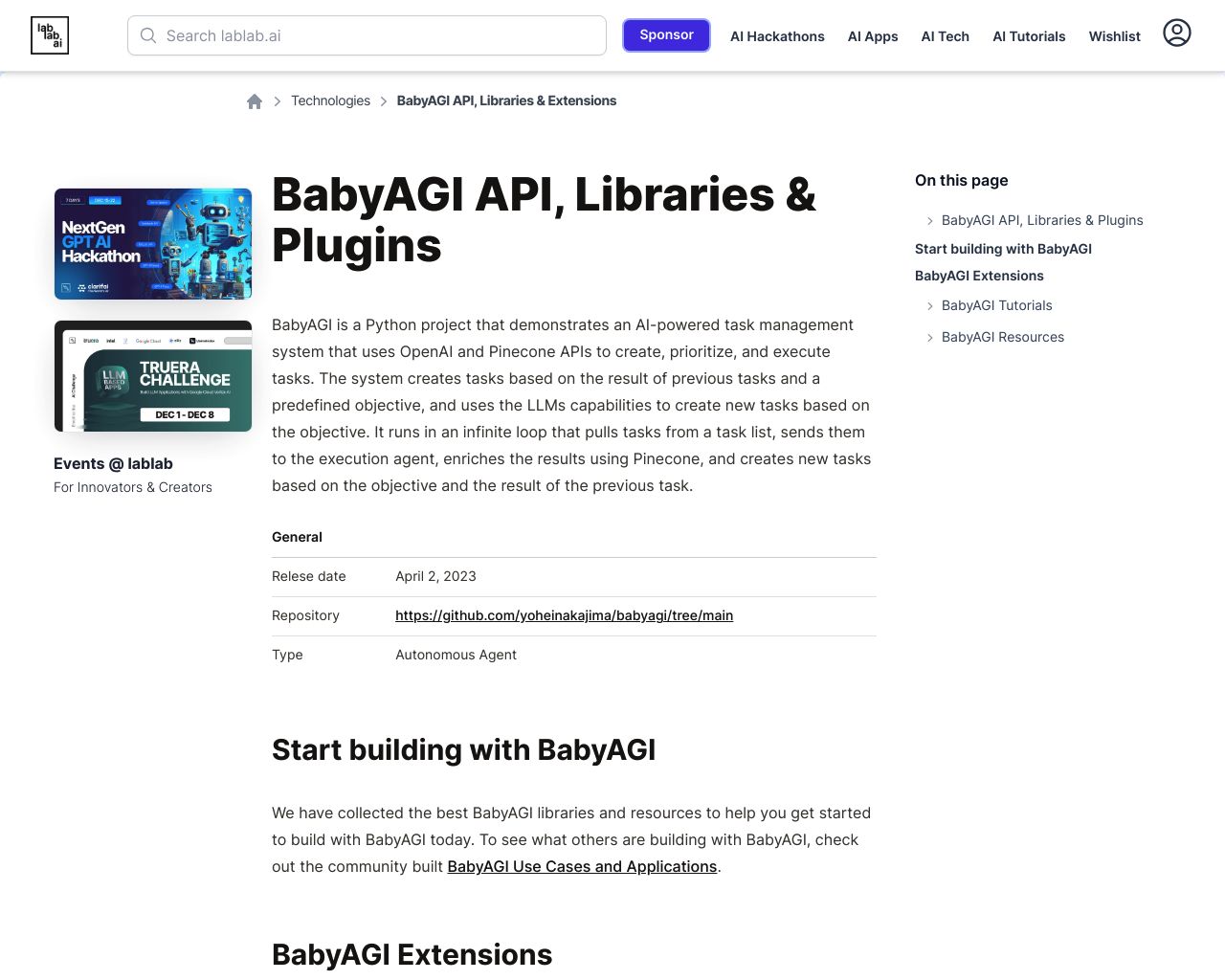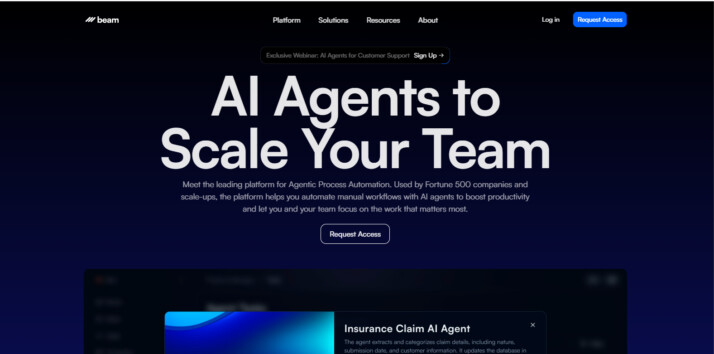BabyAGI vs. Beam AI: Comparing AI-Driven Task Automation Tools
AI-driven task automation and management tools are transforming how businesses operate, with BabyAGI vs. Beam AI at the forefront of this revolution. These platforms offer unique approaches to harnessing artificial intelligence for enhanced productivity and efficiency. BabyAGI simulates human-like cognitive processes for autonomous task management, while Beam AI specializes in Agentic Process Automations for industry-specific applications. This comparison explores their key features, strengths, and limitations, providing developers, business leaders, and AI enthusiasts with insights to make informed decisions. We’ll also introduce SmythOS, a comprehensive alternative that addresses the gaps in both platforms, offering a blend of accessibility, advanced capabilities, and robust security measures.
BabyAGI Overview
BabyAGI revolutionizes task management through artificial intelligence. This open-source project simulates human-like cognitive processes, autonomously generating, prioritizing, and executing tasks based on defined objectives.


Developed by Yohei Nakajima, BabyAGI leverages advanced natural language processing and machine learning techniques. It creates dynamic task lists, adapting to new challenges and learning from previous results. This approach mirrors human problem-solving, making it suitable for complex applications across industries like healthcare, education, and creative writing.
BabyAGI leverages advanced natural language processing and machine learning techniques. It creates dynamic task lists, adapting to new challenges and learning from previous results.
BabyAGI’s core strengths lie in its task-driven autonomy and adaptability. It breaks down objectives into manageable subtasks, executes them efficiently, and iterates based on outcomes. This iterative process enables BabyAGI to tackle intricate problems effectively, offering a glimpse into the future of artificial general intelligence (AGI).
While BabyAGI showcases impressive capabilities, it requires coding knowledge, particularly in Python, for setup and operation. It lacks a visual builder or no-code editor, potentially limiting accessibility for non-technical users. The system primarily operates through command-line interfaces, which may present a learning curve for some.
BabyAGI integrates with Pinecone, a vector database, for storing and retrieving task results. This feature enhances its memory and context-handling capabilities, allowing for seamless information flow between tasks. However, the platform doesn’t offer specific debugging tools or multi-agent collaboration features, which could be valuable for more complex implementations.
Beam AI Overview
Beam AI pioneers the development of autonomous AI agents designed to revolutionize task automation across industries. Their Agentic Process Automations (APAs) excel at handling repetitive manual tasks, allowing organizations to redirect human resources towards more strategic initiatives. These intelligent agents specialize in data extraction, customer inquiry management, compliance automation, and order processing optimization.
Beam AI pioneers the development of autonomous AI agents designed to revolutionize task automation across industries.
The core strength of Beam AI lies in its AI-native approach, leveraging advanced machine learning and natural language processing to create agents that continuously learn and adapt. This results in increasingly precise and efficient task execution over time. The platform caters to diverse sectors, offering tailored solutions for back-office operations, customer service, compliance, and order management.
Beam AI’s commitment to sustainability and efficiency is evident in their approach to minimizing steps in goal achievement and reducing human carbon footprint. The platform’s speed-centric design aims to save time and boost productivity across various organizational processes. Their international team drives innovation, constantly pushing the boundaries of what’s possible with artificial general intelligence (AGI).
Beam AI equips its agents with sophisticated conversational interfaces, enabling seamless integration with existing internal systems for streamlined workflow planning and execution. This comprehensive automation solution aligns with their vision of creating an ethical, AI-driven future where complex workflows are tackled by intelligent agents capable of continuous improvement through learning and adaptation.


While Beam AI offers impressive capabilities, it’s important to note some limitations. The platform may present a steeper learning curve for non-technical users, as it lacks a visual builder or no-code editor. Additionally, features like debug mode, multimodal interactions, and multi-agent collaboration are not explicitly mentioned, which could limit its applicability in certain complex scenarios. The absence of specific data encryption and OAuth features might also be a concern for organizations with stringent security requirements.
Ultimately, Beam AI positions itself as a powerful tool for businesses looking to harness the potential of AI for process automation. Its focus on continuous learning and adaptation makes it a compelling choice for organizations seeking long-term efficiency gains and innovative AI-driven solutions.
Feature Comparison
BabyAGI and Beam AI offer distinct approaches to AI agent development, with key differences in their core components and security features. BabyAGI focuses on autonomous task management, utilizing advanced natural language processing to generate, prioritize, and execute tasks. Its integration with Pinecone for vector storage enhances memory and context handling. However, BabyAGI lacks a visual builder or no-code editor, potentially limiting accessibility for non-technical users.
Beam AI, on the other hand, specializes in Agentic Process Automations (APAs) designed for repetitive manual tasks across industries. While Beam AI emphasizes continuous learning and adaptation in its agents, it doesn’t explicitly offer features like debug mode or multi-agent collaboration. Both platforms have gaps in security features, with neither mentioning specific data encryption practices or OAuth implementation. This contrast highlights the need for users to carefully consider their requirements for AI agent development and deployment when choosing between these platforms.
Feature Comparison Table
| BabyAGI | Beam AI | SmythOS | |
|---|---|---|---|
| CORE FEATURES | |||
| Hosted Agents (Dev, Production) | ❌ | ✅ | ✅ |
| Environments (Dev, Production) | ❌ | ✅ | ✅ |
| Visual Builder | ❌ | ❌ | ✅ |
| No-Code Options | ❌ | ❌ | ✅ |
| Explainability & Transparency | ❌ | ✅ | ✅ |
| Debug Tools | ✅ | ❌ | ✅ |
| Multimodal | ✅ | ❌ | ✅ |
| Human-AI Interaction | ❌ | ✅ | ✅ |
| Audit Logs for Analytics | ❌ | ✅ | ✅ |
| Agent Work Scheduler | ❌ | ✅ | ✅ |
| Logs & Monitoring | ❌ | ✅ | ✅ |
| SECURITY | |||
| Constrained Alignment | ❌ | ✅ | ✅ |
| IP Control | ❌ | ✅ | ✅ |
| COMPONENTS | |||
| Foundation AIs | ❌ | ✅ | ✅ |
| Data Lakes | ❌ | ❌ | ✅ |
| DEPLOYMENT OPTIONS (EMBODIMENTS) | |||
| Staging Domains | ❌ | ✅ | ✅ |
| Production Domains | ❌ | ✅ | ✅ |
| Deploy as Scheduled Agent | ❌ | ✅ | ✅ |
| DATA LAKE SUPPORT | |||
| Hosted Vector Database | ✅ | ❌ | ✅ |
| Sitemap Crawler | ❌ | ❌ | ✅ |
| YouTube Transcript Crawler | ❌ | ❌ | ✅ |
| URL Crawler | ✅ | ❌ | ✅ |
Best Alternative to BabyAGI and Beam AI
SmythOS stands out as the superior alternative to BabyAGI and Beam AI, offering a comprehensive platform for AI agent development and deployment. Our drag-and-drop interface revolutionizes the creation process, making it accessible to users of all skill levels. Unlike BabyAGI’s complex task management system or Beam AI’s narrow focus on repetitive tasks, SmythOS provides unlimited use cases through its versatile toolset.
SmythOS stands out as the superior alternative to BabyAGI and Beam AI, offering a comprehensive platform for AI agent development and deployment.
We surpass both competitors in ease of use and feature richness. Our visual builder eliminates the need for coding expertise, a stark contrast to BabyAGI’s lack of no-code options. SmythOS offers robust debugging tools, multimodal capabilities, and human-AI interaction features that Beam AI doesn’t explicitly provide.
Security is paramount in SmythOS. We implement data encryption and OAuth integration, addressing critical gaps in both BabyAGI and Beam AI’s offerings. Our platform also excels in deployment flexibility, supporting various options from APIs to scheduled agents, which neither competitor fully matches.
SmythOS shines in data handling and integration. Our hosted vector database and support for diverse data sources, including PDF and Word files, outpace both BabyAGI and Beam AI. This comprehensive approach ensures that our users can tackle complex, real-world challenges across industries with unparalleled efficiency and sophistication.
SmythOS shines in data handling and integration… ensures that our users can tackle complex, real-world challenges across industries with unparalleled efficiency and sophistication.
By choosing SmythOS, users gain access to a cutting-edge platform that combines power, flexibility, and user-friendliness. We empower businesses and developers to create AI solutions that truly transform their operations, setting a new standard in the AI agent development landscape.
Conclusion
BabyAGI and Beam AI offer innovative approaches to AI-driven task management and automation, each with unique strengths. BabyAGI excels in autonomous task generation and prioritization, leveraging advanced NLP for complex problem-solving. Beam AI focuses on industry-specific Agentic Process Automations, continuously learning to enhance efficiency in areas like back-office operations and customer service.
However, both platforms have limitations. BabyAGI’s lack of a visual builder may challenge non-technical users, while Beam AI’s absence of explicit features like debug mode or multi-agent collaboration could restrict its versatility. Neither platform fully addresses critical aspects like data encryption or OAuth implementation, potentially raising security concerns for enterprise users.
In contrast, SmythOS emerges as a superior alternative, offering a comprehensive solution that addresses these limitations. Our platform combines an intuitive drag-and-drop interface with extensive integration capabilities, supporting over 300,000 integrations and various AI models. SmythOS prioritizes security with data encryption and OAuth support, while providing versatile deployment options across multiple environments.
We invite you to explore SmythOS’s capabilities and experience the future of AI agent development. Create a free SmythOS account today to unlock unlimited AI agents, risk-free for 30 days or 10,000 tasks. Discover how SmythOS can revolutionize your workflow, offering unparalleled flexibility, security, and efficiency in AI automation.
Last updated:
Disclaimer: The information presented in this article is for general informational purposes only and is provided as is. While we strive to keep the content up-to-date and accurate, we make no representations or warranties of any kind, express or implied, about the completeness, accuracy, reliability, suitability, or availability of the information contained in this article.
Any reliance you place on such information is strictly at your own risk. We reserve the right to make additions, deletions, or modifications to the contents of this article at any time without prior notice.
In no event will we be liable for any loss or damage including without limitation, indirect or consequential loss or damage, or any loss or damage whatsoever arising from loss of data, profits, or any other loss not specified herein arising out of, or in connection with, the use of this article.
Despite our best efforts, this article may contain oversights, errors, or omissions. If you notice any inaccuracies or have concerns about the content, please report them through our content feedback form. Your input helps us maintain the quality and reliability of our information.
